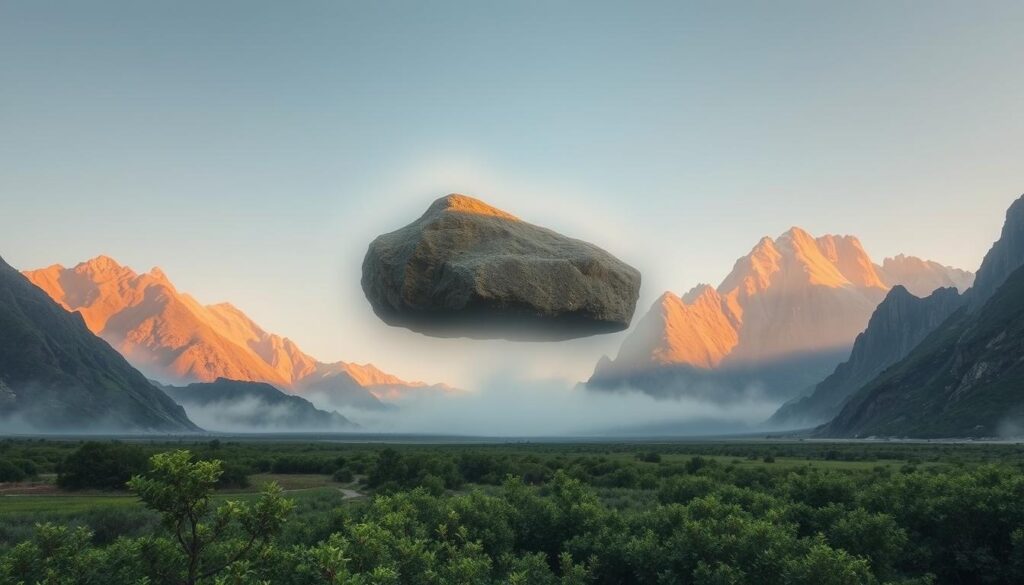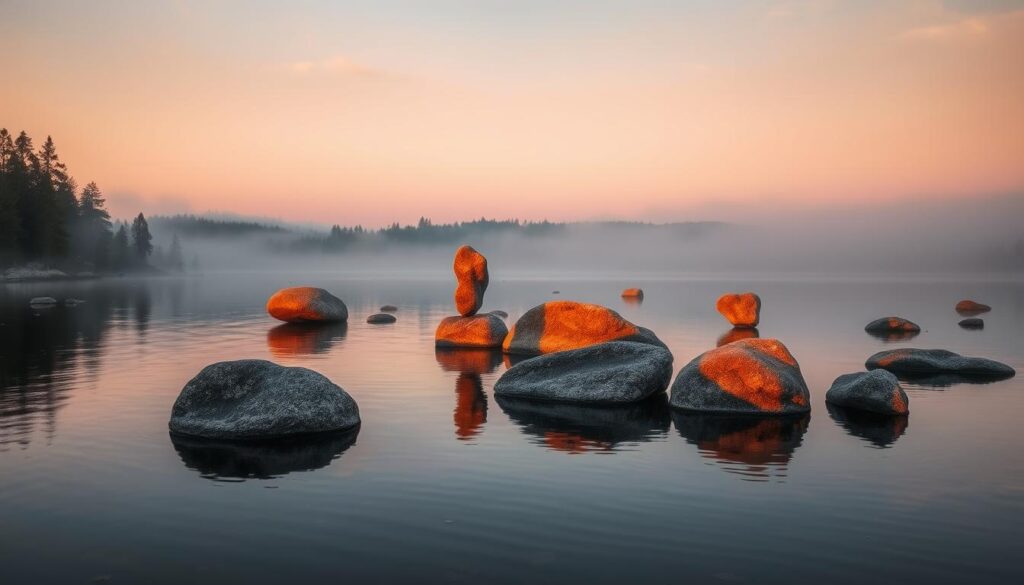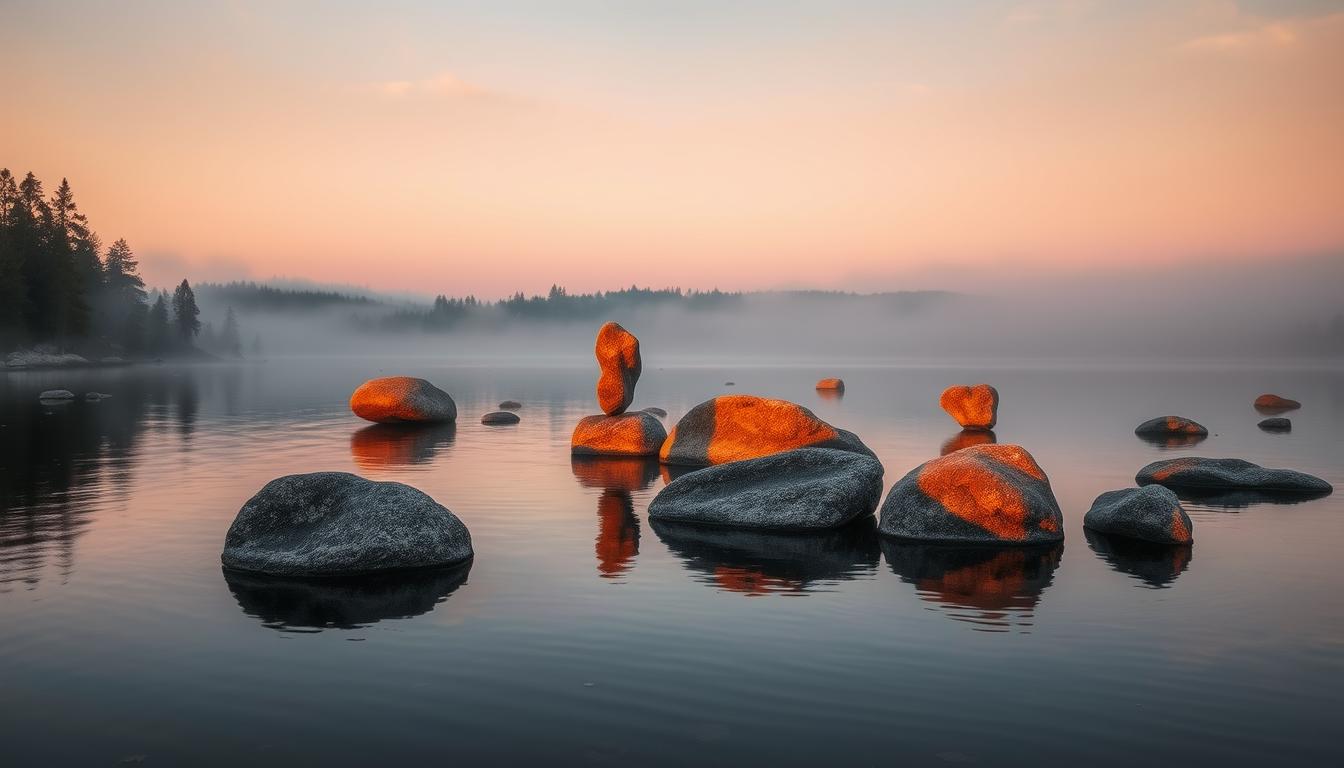Have you ever seen a rock balanced in the air like it’s defying gravity? Floating rocks aren’t just magic tricks—they’re real natural wonders. These gravity-defying rock formations exist in places around the world, puzzling scientists and inspiring awe. How do these magical rocks stay suspended without any visible support? This article uncovers the science and stories behind these gravity-defying marvels.

From ancient myths to modern research, we’ll explore why these natural phenomena exist and how they challenge our understanding of physics. Discover the hidden forces at play and the surprising truth behind nature’s most gravity-defying creations.
Key Takeaways Magical Floating Rock
- Gravity-defying rocks are proven natural phenomena found globally.
- These floating rock formations have sparked curiosity across cultures for centuries.
- Science explains how balance and geology create these magical rocks.
- Visitors can witness these natural wonders in stunning locations worldwide.
- Research continues to uncover new insights into how rocks seemingly defy gravity.
The Mind-Boggling Phenomenon of Levitating Stones
For thousands of years, humans have been amazed by levitating stones. These historical floating rocks seem to defy gravity, sparking endless debate in science, Magical Floating Rock.
First Documented Sightings Throughout History
Levitating stones are mentioned in ancient texts from Egypt and China. Marco Polo wrote about “stones dancing above sand” in Tibet in the 13th century. Magical Floating Rock – In 1673, John Aubrey noted natural anomalies at Rollright Stones in England, where rocks seemed to float.
Today, explorers find new sites like Magnetic Hill in New Brunswick. Here, cars seem to float uphill, Magical Floating Rock.
“These marvels have always whispered secrets of Earth’s hidden forces.” — 19th-century geologist Charles Lyell
What Makes These Stones Different from Ordinary Rocks
| Property | Ordinary Rocks | Levitating Stones |
|---|---|---|
| Density | Typically 2.5–3 g/cm³ | Measured as low as 1.8 g/cm³ |
| Composition | Common minerals like quartz | High magnetite or pyrochlore content |
| Magnetic Response | Neutral | Some show weak repulsion |
The Fascination Behind Natural Anomalies
- They challenge our understanding of physics
- Connect to myths like “messages from gods”
- Spark curiosity about Earth’s undiscovered processes
Today, scientists use 3D scanning and spectrometers to study these unusual stone properties. But the debate goes on. Are they just geological oddities or signs of unseen forces – Magical Floating Rock.
A Rock That Floats in the Air Without Support: Breaking Down the Mystery
Imagine a rock floating in air, without touching the ground. These stones defy gravity in amazing ways. They can be found in remote cliffs and desert plains, leaving people wondering: How does this happen?
In places like Costa Rica’s Rio Celeste and Peru’s Andes, you can see these wonders. Some rocks barely touch the ground, while others seem to float in mid-air. Magical Floating Rock – Their stability can change, sometimes staying the same for years, but other times falling suddenly.
Most of these rocks are visible all year, but weather or light can make them hard to see. They are most visible at dawn or dusk, when shadows make them stand out, Magical Floating Rock.
- Height: Most float between 0.5 to 3 feet above surfaces.
- Stability: Many stay in place for centuries until disturbed.
- Visibility: Best viewed at dawn or dusk when shadows highlight their position.
Geologists study these stones to understand their secrets. Dr. Lena Torres, a geomorphologist, said: “These formations challenge basic physics, but clues lie in their shape, placement, and erosion patterns.”
While myths say they are magical, science says they are caused by erosion, seismic shifts, or mineral deposits. Magical Floating Rock – The next section will explore the forces behind these amazing marvels.
Scientific Explanations Behind Floating Rocks
Earth’s hidden forces shape these gravity-defying marvels. By studying magnetic fields and rock properties, researchers decode how nature achieves the impossible, Magical Floating Rock.
“Gravity’s rules aren’t absolute—nature finds loopholes,” said a 2023 geology study on levitating stones.
Magnetic Field Interactions – Magical Floating Rock
Rocks with high magnetite content act like tiny magnets. When aligned with Earth’s magnetic field, they create natural magnetic anomalies that reduce downward pull. These localized fields can counteract gravity in rare cases, enabling magnetic levitation.
The Role of Density and Composition
- Lightweight minerals: Pumice or volcanic rock’s low rock density reduces weight.
- Magnetic minerals: Magnetite or hematite amplify field interactions.
- Unique shapes: Flat surfaces and balanced weight distribution stabilize floating stones.
Comparing Natural vs. Man-Made Levitation
Natural systems rely on Earth’s energy, while human tech uses electromagnets. Unlike lab setups needing power, these rocks use free energy from mineral deposits. Both exploit magnetic push-and-pull, but nature’s version works without batteries, Magical Floating Rock.
Scientists confirm: no magic, just forces we’re still learning to understand fully. These stones are proof that science and wonder can coexist, Magical Floating Rock.
Famous Locations of Floating Rocks Around the World
From mysterious hills that seem to pull cars skyward to stones balanced atop narrow ledges, floating rock locations attract curious travelers. Magical Floating Rock – These tourist attractions with floating rocks offer a chance to witness nature’s gravity-defying artistry. Let’s explore where to find these wonders:
- Moncton’s Magnetic Hill, Canada: This magnetic hill phenomena site near New Brunswick tricks drivers into thinking their car rolls uphill. Park your vehicle, engage neutral, and feel the pull of this optical illusion.
- Levitating Rock, Costa Rica: Near Arenal Volcano, a boulder appears suspended mid-air. The volcanic rock’s unique erosion creates a balancing act defying natural gravity anomalies worldwide.
- Stone Balancing Sites, Pennsylvania: In the US, Pennsylvania’s Rising Sun Farm showcases stacked stones that seem to float. Families love testing balance games here.
- Buddha Mountain, China: A rock formation resembling Buddha’s face rests on a tiny base, drawing pilgrims and scientists alike.
These sites blend science and wonder. Plan visits during daylight for the best optical effects. Pack a camera—these floating rock locations make unforgettable travel stories!
The Physics of Defying Gravity: How These Rocks Stay Afloat
Nature’s floating rocks seem magical but follow the laws of physics. They defy gravity due to gravitational anomalies and force balance. Even small magnetic fields or air currents can make rocks seem weightless, Magical Floating Rock.
Understanding Anti-Gravity Properties
Anti-gravity is just an illusion. Upward forces balance gravity’s pull. For example, magnetic repulsion or air pressure differences can lift rocks.
This makes them seem to defy gravity, even though gravity still pulls on them. Rocks with special minerals often have a lower effective weight, Magical Floating Rock.
The Balance of Forces at Work
Force equilibrium needs exact conditions. Here’s how it works:
- Magnetic fields push upward against gravity
- Air currents create lift through pressure differences
- Rare earth minerals lower a rock’s density, easing balance
Scientific Studies and Research Findings
Studies use sensors to map magnetic fields around floating stones. Research shows even slight gravitational anomalies let rocks hover. For example, lab tests mimic natural conditions, proving force equilibrium keeps rocks suspended, Magical Floating Rock.
Ongoing research explores how these principles could inspire new tech like levitating vehicles or energy-efficient structures, Magical Floating Rock.
Cultural Significance and Folklore Surrounding Floating Stones
For thousands of years, floating stones have been part of many cultures’ stories and rituals. These mysterious rocks have amazed people, mixing mystery with deep meaning. They appear in floating stones in folklore and have captured the imagination of many, Magical Floating Rock.

- Navajo storytellers describe levitating stones as “sky anchors” holding the world together.
- In Japan, Shinto shrines honor certain rocks as magical rock traditions linked to kami (spirits).
- Maori elders in New Zealand recount tales of floating stones as messengers from ancestral gods.
Spiritual and Mystical Interpretations Magical Floating Rock
Many cultures view these rocks as bridges between worlds. In Nepal, pilgrims visit levitating boulders for healing energy. In Hinduism, some stones are seen as spiritual significance of levitating rocks, used in meditation. Tibetan monks chant near such stones to balance “earth’s energy.”
Modern Pop Culture References Magical Floating Rock
Today, media reimagines these wonders. Movies like Thor: Ragnarok show floating rockscapes inspired by real places. Video games like Assassin’s Creed Origins feature levitating stones as puzzles. Instagram hashtags like #LevitatingWonders trend at spots like Costa Rica’s “Stone of the Moon.”
How to Experience Floating Rocks in Person
Ready to see gravity-defying wonders up close? Start by looking into top visiting floating rock sites like Nevada’s levitating boulders or Costa Rica’s Balún Canán. Planning trips to see floating rocks means checking if you can get there, what the weather is like, and local rules. Don’t forget your camera, level tool, and notebook to capture the moment.
- Book guided tours for expert insights during floating rock tourism excursions.
- Visit at dawn or dusk when lighting enhances the illusion of levitation.
- Bring a magnetometer to test for magnetic anomalies during experiencing gravity anomalies.
Always follow park rules and respect Indigenous land rights. Some places, like Peru’s Yanaraja, need permits. Magical Floating Rock – Test the rocks gently—avoid rocking them to keep their balance. Check their position at different angles to make sure it’s not just an optical trick.
“The true magic lies in observation, not interference.” – National Geographic field guide, 2023
Magical Floating Rock – Share your findings with local geology clubs or online forums. Remember: patience and curiosity are key. These sites do best when visitors care more about preserving them than performing tricks. Whether in India’s Jatinga or Iceland’s Reynisfjara, each place offers a special chance to experience the extraordinary.
Other Natural Phenomena That Seem to Defy Physics
Nature’s secrets are often right in front of us. Besides floating rocks, our planet has natural physics anomalies that question our understanding. Let’s look at three wonders that mix reality and fantasy.
- Sailing stones in Death Valley National Park move without wheels or wings. These rocks slide across dry lake beds, pushed by ice and wind. Scientists only figured out how recently.
- Reverse waterfalls like those at Havasu Falls make it seem like water flows up. Strong winds hold droplets in mid-air, defying gravity with perfect timing.
- Optical illusions in nature play tricks on our eyes all the time. Mirages make deserts look like shimmering lakes. Mountains seem to change size as you get closer—showing that what we see isn’t always real.
These wonders are like the mystery of floating stones, showing nature’s love for surprises. Whether it’s sliding boulders, water flowing up, or mind-bending views, Earth’s rules aren’t always fixed, Magical Floating Rock.
Debunking Myths: Separating Fact from Fiction
Have you seen videos of rocks floating in the air? Many say these are supernatural or alien-made. But most are just floating rock myths or misinterpreted natural phenomena. Science has the real answers. Let’s get to the bottom of it, Magical Floating Rock.

Be careful of debunked levitation claims that ignore physics. Some “floating” stones sit on thin pedestals, creating an illusion. Others use trick photography or magnetic traps. Here’s how to spot the truth – Magical Floating Rock
- Check for peer-reviewed studies, not just social media posts.
- Ask: Does the scientific explanations vs myths balance lean toward evidence?
- Look for measurable data, like rock density or surrounding materials.
Many misinterpreted natural phenomena come from education gaps. A rock’s shape or erosion patterns might trick the eye, but gravity always wins. Experts say debunking doesn’t kill wonder—it deepens it. Knowing why a “floating” boulder stays aloft reveals Earth’s hidden forces, Magical Floating Rock.
Stay curious, but stay critical. Science and mystery aren’t opposites—they’re partners in uncovering nature’s true marvels.
The Future of Research on Gravity-Defying Natural Wonders
Scientists and engineers are exploring gravity research and natural anomaly studies to understand levitating rocks. They use tools like 3D terrain scanning and satellite imaging. Also, people all over the world are helping in these discoveries, Magical Floating Rock.
Ongoing Scientific Investigations
Researchers are using advanced technology to study magnetic fields and rock composition. Places like MIT and NASA are working together on gravity research. They aim to figure out how these rocks float in the air. This could change what we know about geology and physics.
Potential Applications in Engineering and Technology
Lab tests are looking into how technological applications of levitation could change transport or construction. Imagine vehicles that can float without magnets or buildings that defy gravity. These breakthroughs could change how we build and move things.
- Transportation: Magnet-free levitation for trains or drones
- Construction: Materials mimicking natural buoyancy
- Energy: Harnessing earth’s forces for clean power
Citizen Science Contributions to the Field
Anyone can join citizen science projects through apps like RockTrack or GeoMap. People can log sightings, collect data, and work with experts. This makes everyday explorers part of the scientific journey.
Magical Floating Rock – Every discovery brings us closer to solving nature’s mysteries. Maybe we’ll even build a world where gravity’s rules are different.
Capturing the Perfect Floating Rock Photo: Tips and Techniques
Ready to photographing floating rocks and documenting gravity anomalies? First, get the right gear. Use a compact mirrorless camera like the Sony Alpha series or a DSLR like Canon EOS Rebel. These are great for best cameras for natural phenomena.
For stability in windy weather, use a tripod. Wide-angle lenses help show the rock’s surreal size.
- Use natural light during golden hour for warm, dramatic tones.
- Incorporate reference points like people or trees to highlight the rock’s position.
- Shoot in RAW format to adjust exposure later.
When photography techniques for unusual natural events, tell a story. Place the rock against contrasting backgrounds to make it stand out. Add a scale marker like a coin or ruler to help understand the phenomenon.
| Camera Feature | Why It Matters |
|---|---|
| High ISO capability | Captures detail in shadowed areas |
| 4K video mode | Records movement for time-lapse or analysis |
| Weather sealing | Protects gear in outdoor conditions |
Always respect the site. Don’t touch the rocks to keep their balance. Share photos wisely—give credit and avoid sharing exact locations. Every photo you take adds to the mystery of nature.
Conclusion: The Enduring Mystery of Nature’s Floating Marvels
Nature’s secrets, like floating rocks, fill us with wonder. They link ancient myths to today’s science. These mysteries show us how much we still have to learn.
Scientists are trying to figure out how these rocks float. But, there’s still a lot they don’t know. Each floating rock makes us think about physics in a new way.
These wonders connect us to cultures all over the world. They mix folklore with science, sparking our curiosity. Whether in far-off places or our own backyards, they encourage us to explore.
With new technology, we might learn more about these mysteries. But, the thrill of not knowing keeps us going. Visit these places to see these amazing stones for yourself.
Have you seen a rock that defies gravity? Share your story! Join online groups or local clubs to talk about your finds. Together, we keep our curiosity alive.
The search for answers is never-ending. Let these wonders inspire us to keep questioning and marveling at our planet’s secrets.
FAQ
What causes rocks to appear to float?
Floating rocks are often due to special geological formations. They can also be because of magnetic fields and unique minerals. These can make rocks seem to defy gravity under certain conditions.
Are there specific locations known for floating rock phenomena?
Yes! Places like Magnetic Hill in Moncton, Canada, are famous for this. There are also other gravity hills worldwide where rocks seem to float.
How can I experience floating rocks in person?
Visit sites like Magnetic Hill or the Hoover Dam’s gravity hill. Make sure to check how to get there and the best times to see it.
Do floating rocks have anything to do with cultural beliefs?
Absolutely! Many cultures believe in the magic of floating rocks. They see these rocks as sacred or special.
How do I photograph floating rocks effectively?
Use a camera with good zoom to capture the rocks from different angles. Pay attention to the lighting and include objects for scale.
Are there any myths regarding floating rocks that should be debunked?
Yes, many videos and claims are not true. It’s important to think critically and use science to separate fact from fiction.
What technologies are being used to study floating rock phenomena?
Researchers use advanced tools like magnetic field mapping and 3D modeling. These help understand the rocks’ properties and behavior.
Can anyone get involved in research about floating rocks?
Definitely! You can join citizen science projects. This way, you can help collect data and contribute to the study of floating rocks.
Source link
- https://www.youtube.com/watch?v=6zETwhIyJIE
- https://www.universityofcalifornia.edu/news/solving-mystery-floating-rocks
- https://en.wikipedia.org/wiki/2012_Kermadec_Islands_eruption
- https://www.education.com/science-fair/article/floating-rocks/
- https://www.sciencefun.org/kidszone/experiments/fabulous-floating-rocks/
